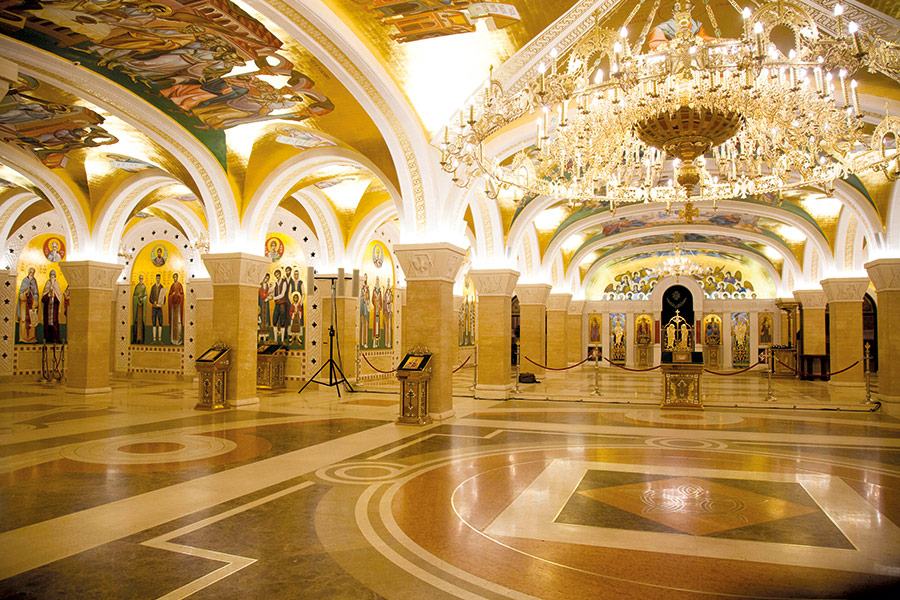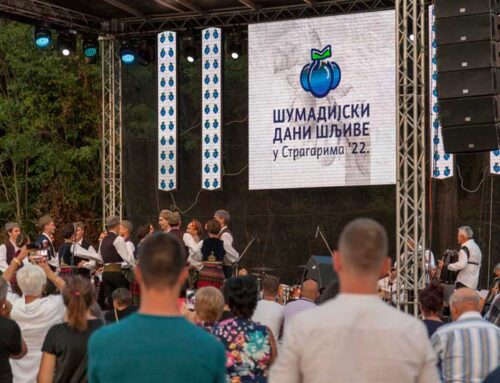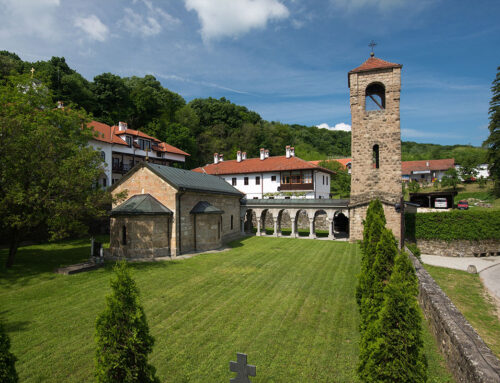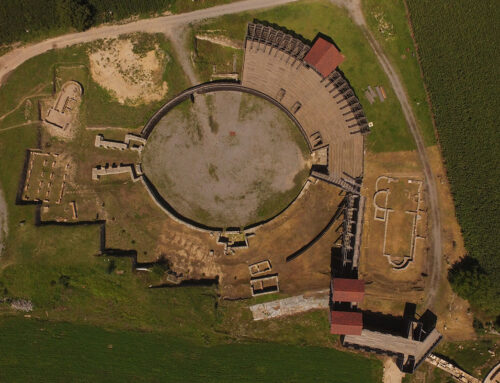Vera, bratstvo, nada, ljubav, spas…
„Rusija i Srbija oduvek su imale posebne odnose. Protkane dubokim razumevanjem… Velike. I verne do kraja“, piše u uvodnom delu vodiča posvećenom ruskom nasleđu u Srbiji, autorka Aleksandra Mikata. Publikaciju je na srpskom i ruskom jeziku objavila Turistička organizacija Srbije sa željom da ona bude putokaz za otkrivanje materijalane, ali i nematrijalne baštine Ruskog naroda posejane širom Srbije.
Najstarija sećanja na veze između Rusa i Srba sežu u doba Kijevske Rusije. U vreme srpsko-turskog rata iz Rusije Srbiji u pomoć stiže hiljade dobrovoljaca i oficira na čelu s generalom Černjajevim.
U Prvom svetskom ratu, car Nikolaj II doslovno je spasio iznemoglu srpsku vojsku kada je od saveznika iznudio njeno prebacivanje na ostrvo Krf. Za rusko spomeničko nasleđe koja danas postoji presudna je bila Oktobarska revolucija. Tada je oko četrdest hiljada emigranata našlo spas u Srbiji koja ih je prihvatila raširenih ruku, a oni su joj se u svakom pogledu odužili. Takođe, oslobođenje od Nemačke okupacije Srbija duguje slavnoj Crvenoj armiji, pa se na Dan pobede, u znak sećanja na heroje Drugog svetskog rata, danas organizuje povorka poznata pod imenom „Besmrtni puk“.
Arhitekta Jalte preobražava prestonicu
Ruski tragovi posebno su vidljivi na licu Beograda i nemoguće je zamisliti kako bi on danas izgledao da ruski neimar Nikolaj Petrovič Krasnov, glavni arhitekta Jalte, nije prihvatio da 1922. godine dođe u Srbiju. Za dve decenije, u potpunosti je promenio izgled Beograda, a njegove monumentalne građevine i danas zadivljuju posmatrače: Skupština Srbije, Palata Vlada Srbije, Ministarstvo spoljnih poslova, Arhiv Srbije… Uredio je i Dvor na Dedinju, crkvu Ružicu na Beogradskoj tvrđavi i projektovao mnoga druga zdanja van glavnog grada – poput Vojničkog groblja na Zejtinliku i Njegoševe kapele na Lovćenu.
Ruski dom i Palata Rusija
Jedan od najvećih ruskih duhovnih centara u inostranstvu je Ruski dom u Beogradu koji je izgrađen prilozima emigranata i vlade Kraljevine Jugoslavije. Autor je vojni inženjer Vasilij Baumgarten, koji je projektovao i Generalštab. Prvobitno, nosio je ime cara Nikolaja, a otvoren je 1933. godine.
Jedno od upečatljivih zdanja i simbola Beograda je današnji hotel Moskva na Terazijama. Prvobitno, bila je to velelepna Palata Rusija u kojoj se nalazilo osiguravajuće društvo. Svečnom otvaranju 1908. godine, prisustvovao je i kralj Srbije Petar I.
Ruska crkva i Iverska kapela
Crkva Sv Trojice na Tašmajdanu izgrađena je 1924. godine, a u njene temelje Belogardejci su položili grumen ruske zemlje. Nikola Pašić, tadašnji predsednik ministarskog saveta Kraljevine SHS, poklonio hramu zvono. U crkvi se čuva deo šala carevića Alekseja Romanova koji su mu sestre isplele dok je još bio u majčinoj utrobi. U hramu se svakog 17. jula, služi liturgija tragično postradalim Romanovima.
Još jedno znamenito mesto je Iverska kapela na Novom groblju. U njoj je služeno opelo mnogim značajnim ljudima, poput Nikolaja Krasnova, Georgija Ostrogorskog, Stepana Kolesnikova… Kraj kapele se nalazi Ruska nekropola i spomenik „Ruske slave“ koje je jedino mesto na svetu gde se 11. novembra odaje pošta vojnicima izginulim u Prvom svetskom rata.
Balet i drugа umeća
Dolaskom umetnika Ruskog baleta Sergeja Đagiljeva i Nine Kirsanove osnovan je baletski ansambl Narodnog pozorišta. Jelena Poljakova, Margarita Forman i Nina Kirsanova bile su neki od pedagoga i koreografa koji su formirali ukus beogradske publike. Bilo je i vrsnih slikara, među njima i Stepan Fjodorovič Kolesnikov – jedan od najznačajnijih realista međuratnog perioda koji je oslikao strop Narodnog pozorišta.
Nekoliko zanimljivosti
* Prva tri pilota srpske civilne avijacije, Striževski, Nikitin i Jermenko, bili su Rusi, kao i osnivač Medicinskog fakulteta u Beogradu Aleksandar Ignjatovski.
* U Velikom Bečkereku (Zrenjaninu) živeo je knez Šeremetjev, unuk cara Nikolaja Prvog, a u Novom Sadu grofica Sofija Tolstoj.
* U Kragujevcu se, u Ulici Kralja Aleksandra I Karađorđevića, nalazi kopija Tolstojeve kuće Jasna Poljana.
* Na Avali je podignut Spomenik sovjetskim ratnim veteranima koji su poginuli u avionskom udesu dolazeći na proslavu 20-godišnjice oslobođenja Beograda. Među njima su bili maršal Sergej Birjuzov i general Vladimir Ždanov.
Sremski Karlovci
Prva rusko-srpska škola otvorena je 1725. godine u Sremskim Karlovcima kada je po ukazu carice Katarine došao sveštenik Maksim Suvarov. Njegovi će đaci otvarati škole širom Srbije. U Karlovcima je živeo i baron Vrangel, a sa njim se naselilo i pedesetak intelektualaca i najvernijih oficira. Većina njih počiva na Čeratskom groblju. Pored spomenika generalu Vrangelu i ruskog groblja, mogu se videti i česma Svetog Andreja Prvozvanog, kao i spomenik Raguzinskom, trgovcu, diplomati i osnivaču ruske tajne službe, koji je bio u službi cara Petra Velikog.
Niš, Kragujevac, Novi Sad
Narodno pozorište u Nišu projektovao je Vsevolod Tatarinov, Skupštinu Opštine Aleksandar Medvedev, a Spomenik na Čegru rad je Julijana Đupona. Narodni muzej Niša obiluje delima ruskih umetnika. Kragujevac je imao sreću da ga ukrase radovi neimara Georgija Kovaljevskog: kompleks žute gradske tržnice i Požarni dom. U Novom Sadu nastanilo se oko dve hiljade emigranata – ubrzo u Srpskom narodnom pozorištu formira se balet, osniva prvi šahovski klub, a Dom vojske, Dom zdravlja i prve višespratnice projektuje arhitekta Georgije Šreter.

















Social Network